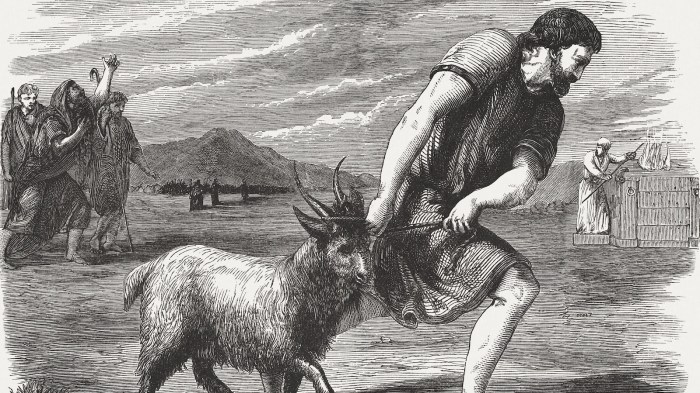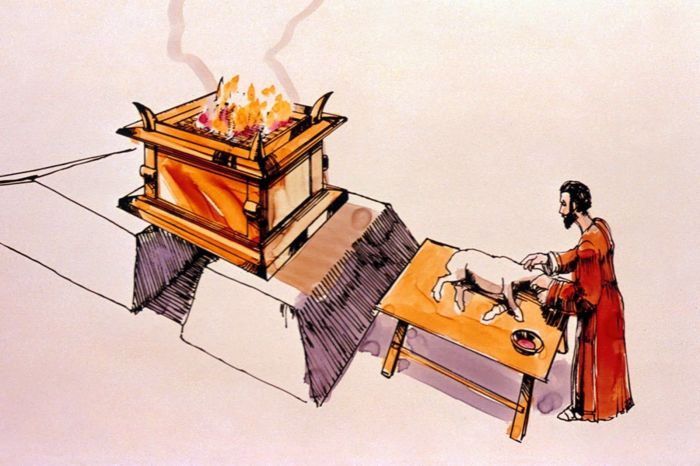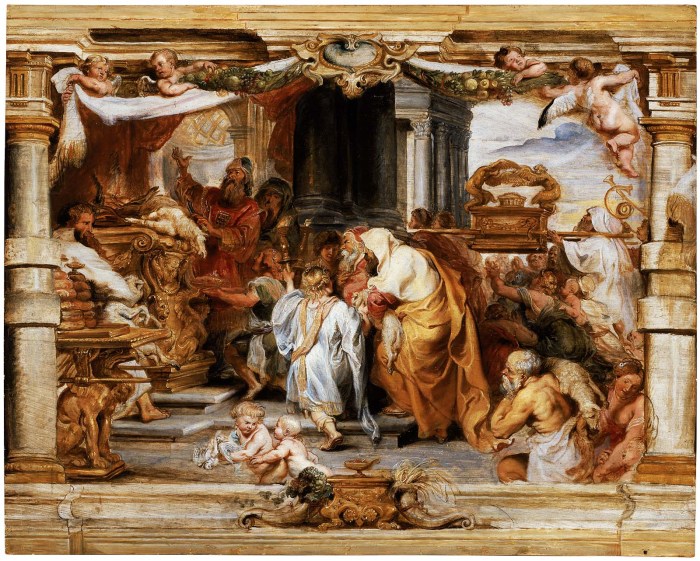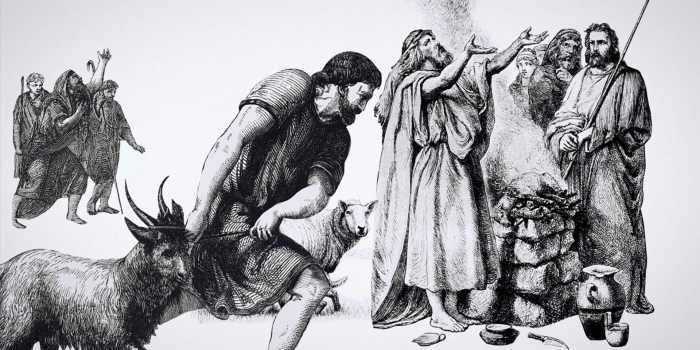Sacrificios en el antiguo testamento – Sacrifices in the Old Testament, an integral aspect of ancient Israelite religious practices, hold profound theological and historical significance. This exploration delves into the diverse types of sacrifices, their ritual practices, and the prophetic critique that challenged their sole reliance.
The Old Testament narrative provides a rich tapestry of sacrificial practices, revealing their role in atonement for sin, reconciliation with God, and the foreshadowing of Christ’s redemptive sacrifice.
Historical Context
Sacrifices played a central role in the religious practices of ancient Israel. They were rooted in the cultural and historical background of the ancient Near East, where sacrifices were common practices in various religious traditions.
In ancient Israel, sacrifices were primarily associated with the worship of Yahweh, the national deity. They were seen as a way of expressing devotion, seeking forgiveness for sins, and offering thanks for divine blessings.
Types of Sacrifices
Various types of sacrifices were practiced in ancient Israel, each with its specific purpose and significance.
- Burnt offerings:These were complete offerings in which the entire animal was burned on the altar. They were often used to express devotion or to atone for sins.
- Grain offerings:These consisted of flour, oil, and incense. They were typically offered as an expression of thanksgiving or to accompany other sacrifices.
- Peace offerings:These involved the sacrifice of an animal, but only a portion of the animal was burned on the altar. The rest was shared among the priests and the offerer.
- Sin offerings:These were offered to atone for specific sins committed by individuals or the community.
- Guilt offerings:These were similar to sin offerings but were specifically related to offenses against others or against the sanctuary.
Theological Significance
Sacrifices played a pivotal theological role in the Old Testament, serving as a means of atonement for sin and fostering reconciliation with God.
The concept of sin permeated the Old Testament narrative, with transgressions ranging from ritual impurities to moral offenses. These sins created a barrier between humans and a holy God, necessitating a way to restore fellowship and appease divine wrath.
Atonement for Sin
Sacrifices served as a means of atonement, symbolizing the transfer of sin from the sinner to the sacrificial animal. Through the shedding of blood, the life of the animal was offered as a substitute for the life of the sinner, providing a temporary covering for sin.
The ritual of sacrifice involved the presentation of the animal at the altar, the laying on of hands by the sinner to transfer their guilt, and the slaughter of the animal. The blood was then sprinkled on the altar or other sacred objects, symbolizing the cleansing and purification of the sinner from their transgressions.
Reconciliation with God
By offering sacrifices, individuals could express their repentance and seek reconciliation with God. The act of sacrifice demonstrated their willingness to acknowledge their sin, accept God’s judgment, and make amends for their wrongdoing.
The sacrifices also served as a reminder of the consequences of sin and the need for obedience to God’s commands. By witnessing the death of the sacrificial animal, individuals were confronted with the seriousness of their transgressions and the importance of living in accordance with God’s will.
Ritual Practices
Sacrificial practices in the Old Testament were meticulously regulated, with specific rituals and procedures to be followed. These rituals were designed to ensure the proper offering and acceptance of sacrifices by God.
The preparation of sacrifices involved the selection of unblemished animals, which were to be examined carefully for any defects. The animals were then slaughtered in a specific manner, with the blood being collected in a basin. The entrails and other parts of the animal were removed and washed, while the meat was cut into pieces.
Offering of Sacrifices
The offering of sacrifices was a central aspect of the ritual. The priest would place the pieces of meat on the altar, along with other offerings such as grain and wine. A fire would then be lit on the altar, and the offerings would be consumed by the flames.
The smoke from the burning sacrifices would rise to heaven, carrying the prayers and petitions of the people.
Consumption of Sacrifices
In certain types of sacrifices, such as peace offerings, a portion of the meat would be consumed by the priests and the offerers. This act of sharing in the meal symbolized the fellowship between God and his people. The remaining meat could be taken home and eaten by the offerers and their families.
Prophetic Critique: Sacrificios En El Antiguo Testamento

The prophetic critique of sacrifices in the Old Testament challenged the prevailing emphasis on ritualistic practices and highlighted the importance of ethical conduct and compassion.
Prophets such as Amos, Hosea, and Isaiah denounced the empty and hypocritical nature of sacrifices offered without genuine repentance and a commitment to justice. They argued that God desired not mere external observances but a transformation of the heart and a life lived in accordance with his commandments.
Rejection of Ritualism
- Amos condemned the reliance on sacrifices while neglecting the poor and oppressed, declaring, “I hate, I despise your feasts, and I take no delight in your solemn assemblies” (Amos 5:21).
- Hosea criticized the people for offering sacrifices while engaging in idolatry and injustice, stating, “Your sacrifices are like the bread of mourners, for all who eat of them are defiled” (Hosea 9:4).
Emphasis on Ethics
- Isaiah emphasized the importance of justice and righteousness, declaring, “Learn to do good; seek justice, correct oppression; defend the fatherless, plead for the widow” (Isaiah 1:17).
- Jeremiah condemned those who offered sacrifices while shedding innocent blood, stating, “Your hands are defiled with blood, and your fingers with iniquity” (Jeremiah 2:34).
Types of Sacrifices

Sacrifices in the Old Testament can be categorized into various types, each with its distinct purpose and characteristics. These sacrifices served as a means of expressing devotion to God, seeking forgiveness, or offering thanksgiving.
The following table summarizes the main types of sacrifices mentioned in the Old Testament:
| Type | Purpose | Example |
|---|---|---|
| Burnt Offering (olah) | Complete surrender to God; expression of worship | Leviticus 1:1-17 |
| Grain Offering (minchah) | Thanksgiving or consecration; symbol of dependence on God | Leviticus 2:1-16 |
| Peace Offering (shelamim) | Thanksgiving, fellowship with God, or sealing of a covenant | Leviticus 3:1-17 |
| Sin Offering (chatta’t) | Atonement for unintentional sins | Leviticus 4:1-35 |
| Guilt Offering (asham) | Atonement for intentional sins or violations of the law | Leviticus 5:1-19 |
Symbolic Meaning

Sacrifices in the Old Testament carried profound symbolic meanings that foreshadowed the sacrificial death of Christ and the redemption of humanity. They served as tangible representations of the brokenness of humanity and the need for atonement.
Christ’s Sacrificial Death, Sacrificios en el antiguo testamento
The shedding of blood in animal sacrifices symbolized the shedding of Christ’s blood on the cross. The innocent animals sacrificed represented Christ’s sinlessness and willingness to lay down his life for the sins of the world. The act of sacrificing an animal signified the transfer of sins from the offerer to the victim, pointing to Christ’s role as the ultimate sacrifice for the sins of humanity.
Redemption of Humanity
Through sacrifices, the offerer expressed their faith in God’s provision for redemption. The blood of the sacrificed animal covered the sins of the offerer, symbolizing the cleansing and forgiveness of sins. The sacrifice became a means of reconciliation between God and humanity, foreshadowing the redemptive work of Christ on the cross.
Literary Analysis

The biblical narrative surrounding sacrifices in the Old Testament employs a rich tapestry of literary devices and motifs to convey their significance and impact. Recurring themes and patterns emerge, shaping the understanding of this central ritual practice.
Motif of Blood
Blood is a prominent motif in sacrificial rituals, symbolizing life and atonement. The shedding of blood, whether animal or human, was believed to appease the deity and purify the offerer from sin. This motif emphasizes the sacrificial act’s redemptive and restorative nature.
“For the life of the flesh is in the blood, and I have given it to you upon the altar to make atonement for your souls; for it is the blood that makes atonement, by reason of the life.”(Leviticus 17:11)
Theme of Covenant
Sacrifices played a crucial role in establishing and maintaining the covenant between God and Israel. They served as a physical expression of the covenant relationship, symbolizing obedience, loyalty, and communion. Through the sacrificial act, the offerer acknowledged their dependence on God and sought his favor and protection.
Pattern of Ritualization
Sacrificial practices in the Old Testament followed a specific pattern or ritual. The offerer would bring an animal to the sanctuary, lay hands on it, and slaughter it. The blood would be sprinkled on the altar, and the meat would be burned or consumed.
This ritualized process ensured the proper and reverent performance of the sacrifice.
Comparative Study
Sacrifices played a significant role in the religious practices of the ancient Near East, including the Old Testament. While there were similarities in practices and beliefs, there were also notable differences.
Similarities
- Offerings to deities:Sacrifices were made to honor, appease, or seek favor from deities.
- Blood as a vital element:In many cultures, the shedding of blood was considered essential for sacrifice.
- Symbolic representation:Sacrifices often symbolized the transfer of guilt, sin, or thanksgiving to the deity.
Differences
- Frequency and purpose:Sacrifices in the Old Testament were more frequent and specific than in other cultures. They were primarily for atonement, communion with God, or purification.
- Type of sacrifices:The Old Testament prescribed various types of sacrifices, including burnt offerings, sin offerings, and peace offerings. Other cultures had a wider range of sacrifices, including human sacrifices.
- Role of priests:In the Old Testament, only authorized priests could perform sacrifices. In some other cultures, sacrifices could be made by individuals or families.
- Emphasis on ethics:The Old Testament emphasized the ethical dimension of sacrifice, stressing the importance of repentance and obedience. Other cultures focused more on the ritualistic aspects.
Archaeological Evidence
Archaeological discoveries provide tangible evidence that corroborates the biblical accounts of sacrifices in the Old Testament.
Excavations have uncovered numerous sacrificial altars, some dating back to the Bronze Age. These altars are typically made of stone and display signs of repeated use, such as discoloration or burnt offerings. Artifacts associated with sacrifices, such as ceramic vessels, knives, and incense burners, have also been found.
Discovery of Inscriptions
In addition to physical artifacts, archaeological research has yielded inscriptions that shed light on sacrificial practices. The Tel Dan Stele, dating back to the 9th century BCE, mentions the “House of David,” confirming the biblical narrative. The Moabite Stone, discovered in the 19th century, provides an account of King Mesha’s victory over Israel and includes references to sacrifices.
Contemporary Relevance

The concept of sacrifice remains central to Christian faith and practice, despite the cessation of animal sacrifices in the New Testament. The sacrificial system of the Old Testament provides a framework for understanding the redemptive work of Christ and the nature of Christian worship.
Sacrifice and Worship
In the Old Testament, sacrifices were an integral part of worship. They were a means of expressing gratitude, seeking forgiveness, and making atonement for sins. Christians understand that the ultimate sacrifice was made by Jesus Christ on the cross. His death and resurrection provide the basis for forgiveness of sins and reconciliation with God.
Sacrifice and Redemption
The Old Testament sacrifices pointed forward to the redemptive work of Christ. The shedding of blood in sacrifices symbolized the payment of a debt for sin. In the New Testament, Jesus’ death is seen as the ultimate sacrifice that atoned for the sins of humanity.
Detailed FAQs
What were the different types of sacrifices in the Old Testament?
The Old Testament mentions various types of sacrifices, including burnt offerings, grain offerings, peace offerings, sin offerings, and guilt offerings, each with specific purposes and rituals.
What was the theological significance of sacrifices?
Sacrifices symbolized atonement for sin, acknowledging human wrongdoing and the need for reconciliation with God. They pointed to the future sacrifice of Christ, who would ultimately fulfill the role of the perfect sacrifice.
How did the prophets critique sacrifices?
Prophets such as Isaiah, Jeremiah, and Amos emphasized the importance of ethical conduct and compassion over mere ritualistic practices. They denounced sacrifices offered without genuine repentance and a transformed heart.